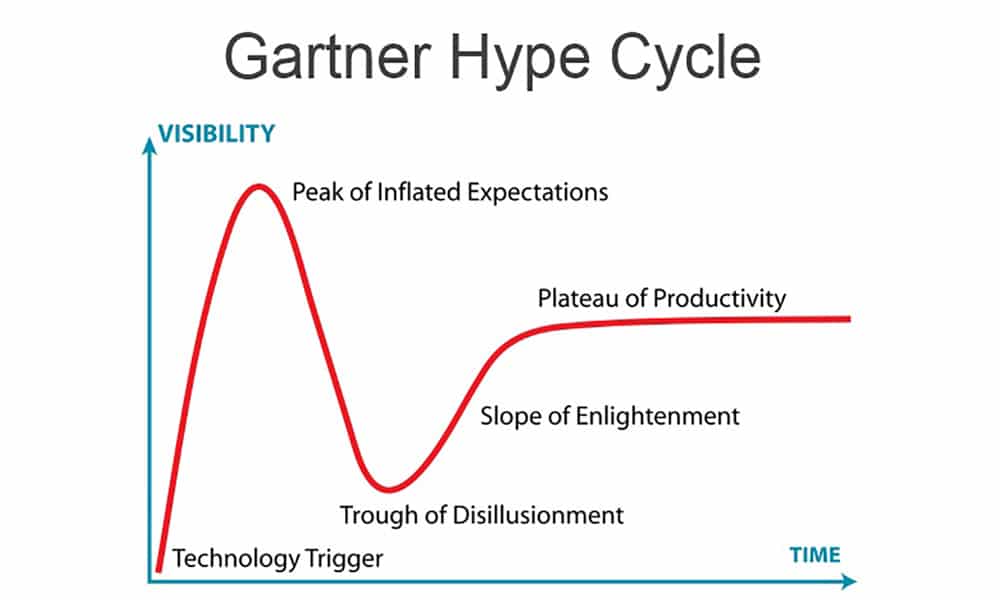Few technology analyses display the elegance and essential understandability of the famed Gartner Hype Cycle. First published in 1995, the Hype Cycle purports to illustrate, over a longitudinal analysis of technology trends, the truth of Amara's Law - coined by the late scientist Roy Amara, which states that we tend to overestimate the effect of a technology in the short run and underestimate the effect in the long run. Published annually, the Hype Cycle – though not without criticism – provides a useful snapshot of the latest technology trends and how likely they are to impact our marketing planning. Many of these technology trends will potentially impact our customer strategy – so let’s take a look at where “relationship tech” falls on the hype cycle.
By Rick Ferguson
First, a Hype Cycle primer may be useful. Per Gartner (see accompanying illustration) the Hype Cycle illustrates what Icon Ventures partner Michael Mullany calls a “hero’s journey” for technology. Here’s a description of the five distinct stages of a technology’s life cycle as defined by Gartner (all text courtesy of Gartner):
Innovation Trigger: A potential technology breakthrough kicks things off. Early proof-of-concept stories and media interest trigger significant publicity. Often no usable products exist and commercial viability is unproven.
Peak of Inflated Expectations: Early publicity produces a number of success stories — often accompanied by scores of failures. Some companies take action; many do not.
Trough of Disillusionment: Interest wanes as experiments and implementations fail to deliver. Producers of the technology shake out or fail. Investments continue only if the surviving providers improve their products to the satisfaction of early adopters.
Slope of Enlightenment: More instances of how the technology can benefit the enterprise start to crystallize and become more widely understood. Second- and third-generation products appear from technology providers. More enterprises fund pilots; conservative companies remain cautious.
Plateau of Productivity: Mainstream adoption starts to take off. Criteria for assessing provider viability are more clearly defined. The technology's broad market applicability and relevance are clearly paying off.

Over the past 20+ years, Gartner has used its annual Hype Cycle release as an effective snapshot of current technology trends. As Gartner puts it, “the Hype Cycle for Emerging Technologies report [provides] a cross-industry perspective on the technologies and trends that business strategists, chief innovation officers, R&D leaders, entrepreneurs, global market developers and emerging-technology teams should consider in developing emerging-technology portfolios. This Hype Cycle specifically focuses on the set of technologies that is showing promise in delivering a high degree of competitive advantage over the next five to 10 years.”
So where does “relationship tech” – which we define as technology with the potential to reward and recognize best customers to build profitable, long-term customer relationships – fit into the 2017 Hype Cycle for Emerging Technologies? Here’s a summary of the key trends courtesy of Gartner:
Augmented reality (AR): AR is a live direct or indirect view of a physical, real-world environment whose elements are "augmented" by computer-generated sensory input such as sound, video, graphics or GPS data. AR currently sits in the “Trough of Disillusionment,” perhaps driven the by the market failure of Google Glasses and the collapsed hype bubble around last year’s Pokémon Go fad. Gartner estimates a 5-10-year path to mainstream adoption.
Autonomous Vehicles: In addition to all the other ways driverless vehicles will transform modern society, marketers are salivating over the potential insight gained from the data manufacturers and marketers would almost certainly collect from these connected vehicles. The bad news: Gartner currently places autonomous vehicles at the Peak of Inflated Expectations and estimates more than ten years to mainstream adoption
Blockchain: Everyone’s favorite cryptographic distributed ledger platform, currently the foundation of several startups around the world threatening to disrupt the loyalty industry, has passed the Peak of Inflated Expectations and is now plummeting into the Trough of Disillusionment with a 5-10-year path to adoption. We’ve covered blockchain at length, and we’ve come to a similar conclusion: while blockchain will most certainly play a role in streamlining transactions and reducing fraud, its ability to render traditional loyalty marketing models obsolete is, thus far, overrated.
Machine Learning: Every sophisticated loyalty operator is talking about the ways that machine learning is transforming their ability to derive insight from customer data. For all the hype around Machine Learning, however, it’s worth noting that most “machine learning” applications are still built around traditional analytical tools and techniques rather than built around more sophisticated neural networks. The potential is there, but Gartner estimates a two-to-five year path to adoption with the potential to drop into the Trough of Disillusionment.
Connected Homes: Every marketer looks forward to the day when we can build relationships with consumers directly through the devices in their homes. Provided any data leveraged through these devices is collected transparently and used with permission, the potential to build real emotionally-driven relationships through connected devices is epic – but, according to Gartner, that day is still 5-10 years away.
Virtual assistants: Driven by early breakthroughs such as Apple’s Siri, and now becoming more prevalent through the increasing presence in the home of Amazon’s Alexa and Google Assistant, Virtual Assistants possess the potential to disrupt marketing as profoundly as the internet did 20 years ago – imagine, for example, the difference between a consumer searching for “running shoes” via a mobile Google search and retrieving a list of results, versus a consumer asking, “Alexa, where can I find the best running shoes?” Fortunately for marketers, the path to mainstream adoption is still 5-10 years away.
As we mentioned, the Gartner Hype Cycle is not without its critics; researchers studying Gartner’s predictions have often failed to find a correlation between those predictions and the actual path to adoption for many technologies. And, if we’re being picky, it isn’t really a “cycle.” Those quibbles aside, the Hype Cycle is a useful metaphor, a reasonably accurate snapshot of current tech trends, and a reminder to marketers that technology enables, but imagination wins. Evaluate every emerging technology by its ability to build strong customer relationships, and you’ll usually stay on the swiftest path to success.
Rick Ferguson is Editor in Chief of the Wise Marketer Group.




